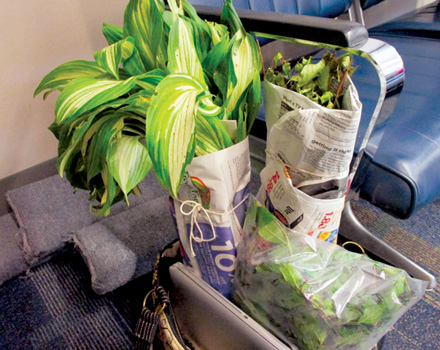Traveling with Plants

I wasn’t planning on bringing a carry-on full of plants back from my trip out East earlier this summer but then no one was particularly surprised, either. A visit to one of my brother’s homes usually includes working in their gardens so bringing plants back home has become somewhat of a tradition. In the past, though, I was driving to and from their homes. This time, I flew home.
My fellow travelers seemed intrigued with the idea. One New York traveler called me “brave” for bringing plants along. Another lady heading back to London said she “completely understood” and asked about the different crape myrtle varieties. And a stewardess, who said she “got” why I even had the plants, reminded me I could place the bag full of plants in the empty seat next to me after we left LaGuardia Airport in New York, which was kind of her and prevented my bag from getting kicked while it was tucked under the seat.
The plants I wanted to bring with me were not exotic – hostas, crape myrtle starts and crape myrtle cuttings; iris and daffodil bulbs.
The iris were simple. After cutting the green flags down to 6 inches, those were wrapped in the bundle of dug up daffodil bulbs. All were packed in a plastic bag tucked into my clothing in my checked bag. It did cross my mind the next time I visit I should just skip bringing clothes and carry an empty suitcase, just in case. I can always raid my family’s closet while I am there, especially for gardening clothes.
Those could also have been shipped separately in a box. After all, that’s how nurseries ship bulbs and plants.
The hostas were originally from a New York homestead so they had sentimental value. After hearing about their origins, a good dozen were carefully stuffed into an empty dog biscuit cardboard box wrapped in newspaper; then the plants themselves were wrapped tightly in more newspaper to keep them from breaking. I wrapped those up the night before.
During the trip, only one hosta leaf was lost.
Plant starts with roots need either soil or good hydration so those crape myrtle roots were wrapped in wet newspaper and placed in a plastic bag. More newspaper wrapped the plants tightly but gently. They will lose their leaves as they settle in anyway so the packaging was more to protect the stems.
Finally, the crape myrtle cuttings were kept in water until the morning of the trip. Each bundle was wrapped in wet paper towels, then stuffed in a wet sock and tucked into a plastic bag. A second bag over the top kept leaves nicely hydrated throughout the trip.
By the time, I arrived home, these looked as fresh as when I cut them.
Also use a padded carry-all with a shoulder strap to minimize plant damage and make carrying easier.
Some states do have restrictions on bringing plants in so double check before bringing plants in.
Charlotte Ekker Wiggins is a beekeeper, gardener and sometimes cook. Published by El Dorado Springs Sun once in print and online with author’s permission. Copyright 2017, all rights reserved. This column may not be reprinted, republished or otherwise distributed without author’s permission. Contact Charlotte at gardeningcharlotte at gmail dot com.

IF IT’S GOOD FOR MY COMPUTER – A padded carry-all for my laptop came in handy to carry several swaddled bundles of plants from Virginia back to Missouri.
 IF IT’S GOOD FOR MY COMPUTER – A padded carry-all for my laptop came in handy to carry several swaddled bundles of plants from Virginia back to Missouri.
IF IT’S GOOD FOR MY COMPUTER – A padded carry-all for my laptop came in handy to carry several swaddled bundles of plants from Virginia back to Missouri.



Facebook Comments